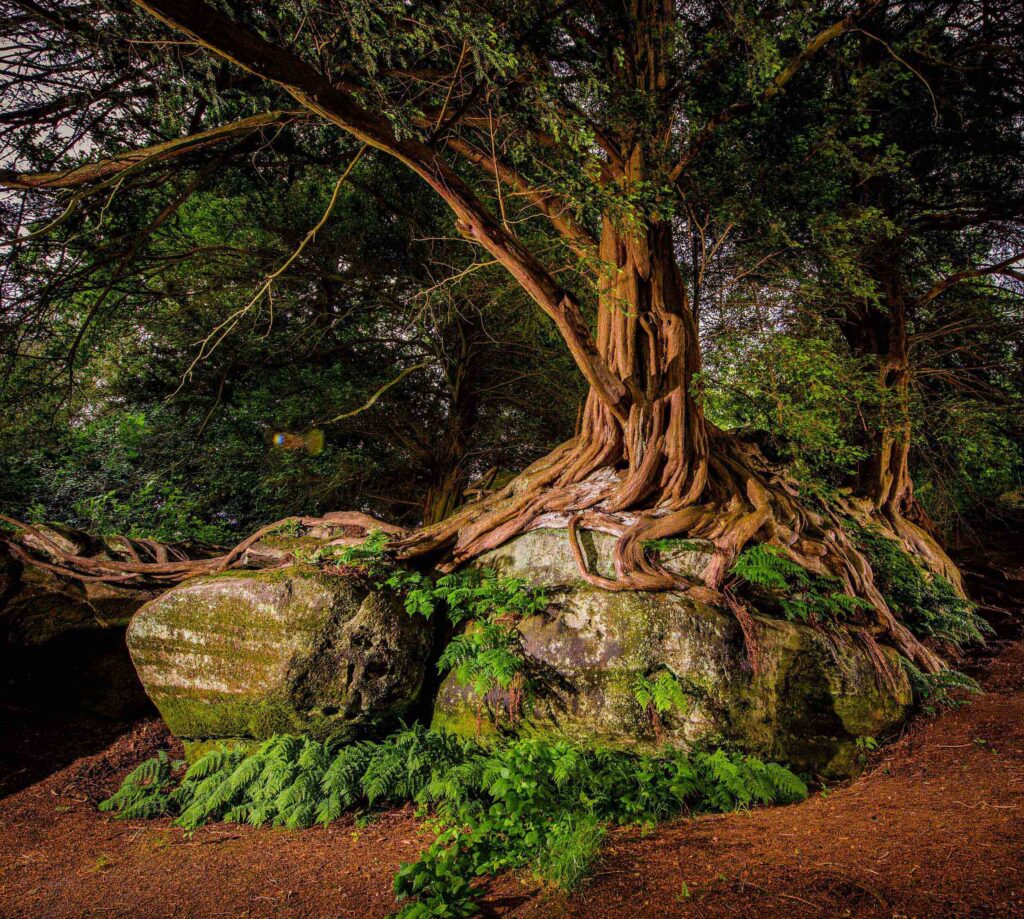Rooted at Wakehurst, Kew, opens on 7 July and features a host of different artistic approaches to the humble tree
This summer, Wakehurst, Kew’s wild botanic garden in Sussex, celebrates one of the world’s most recognisable and loved plants – trees. Vital to human existence, trees form the life support of the planet, from storing carbon and sheltering wildlife, to providing shade and being scientifically proven to ease stress. In recognition of the phenomenal power of these woodland wonders, Wakehurst has commissioned a series of award-winning artists to create a series of spectacular outdoor installations across the 535-acre site.
Forming Wakehurst’s largest summer programme to date, the eight installations capture a broad range of artistic practices, from sculpture to sound. Taking inspiration from Wakehurst’s varied landscapes and ecology, each piece will explore a distinct theme and allow visitors of all ages to explore new perspectives on nature.

Chila Burman brings her signature colourful style to the heart of the Wakehurst landscape in a new major commission, celebrating the inspiring impact trees have had on her practice since childhood. The 10m structures form a joyful explosion of vibrant neon colours, accompanied by delicate creations in the shape of bees, illustrating the close relationship which exists between trees and invertebrates, and the threat climate change poses to them.
Acclaimed sculptor Joseph Hillier similarly reflects on the communication network hidden in nature in his series of human portraits carved from trees lost to Storm Arwen in Northumberland, in a considered effort to make art in a more sustainable way. The hand-crafted sculptures will sit upon plinths, creating their own network of quiet exchange, inviting visitors to contemplate their place in the wider natural world. Exposing once hidden decay, the work will also draw attention to the threat of fungal diseases that plague many tree species across the country, including ash dieback and Dutch elm disease.
Two further creatives draw inspiration from the incredible power of nature networks. Little Lost Robot, a not-for-profit collective of social practice artists create their own Wood Wide Web in a collection of interactive installations exploring the relationship between trees, fungi and wildlife. From a tree sap pump that sends vital nutrients and minerals through the trunk, to a bespoke sound piece hidden in coiled set of root-like structures, and a giant robotic wood mouse that can be fed mycelium pellets, younger visitors are treated to a stimulating new way of engaging with the natural world.
Hidden Orchestra, created by composer, producer and multi-instrumentalist Joe Acheson, returns to Wakehurst with a new immersive soundscape work Sonic Woodland IV. The audio work creates an enveloping sound experience using a bespoke system designed by spatial audio engineer Tim Southorn, coupling the sounds of the botanical forest with generative music, to create a living piece of music which is constantly evolving, reflecting the non-human timescales of the interactions which are constantly unfolding between plants, trees, and the underground mushroom networks in the woods.
Many works will respond to critical Kew science projects, creating installations that see art and science collide, highlighting how much there is still to learn about trees – from pioneering research to combat ash dieback, to the positive impact of woodlands on wellbeing.

Artist Geraldine Pilgrim in her newly commissioned work Tattoo explores the “dynamics of carbon” with an ancient oak tree created from recycled branches sourced from the grounds at Hatfield House. Emerging from limestone boulders etched with constellations and crystal stars, the trunk and branches are tattooed with the shadows of the absent oak leaves highlighting how not only carbon black was used for the first tattoos but also how this “King of Elements”, carbon, is made from the interiors of stars.
Researching the most effective carbon-capturing plants and fungi underpins a major science research programme at Wakehurst, Nature Unlocked. Using Wakehurst as a ‘living laboratory’ scientists are collecting carbon data across different habitats, and exploring the previously untapped powers of underground fungal networks, or mycelium. Mycelium forms a key material in Mycelium Bar, a collaborative architectural piece from creative studio La Succulente, artist Côme di Meglio and designer We Want More. Kindly donated to RBG Kew, the striking bar will sit in the Wakehurst landscape, providing a space for people to dwell and connect, and ultimately will decompose and serve as a fertiliser for the soil.
Further installations include a new trail of scorched tree monoliths, the remaining trunks and stumps of trees felled as a result of the fungal tree disease, ash dieback. The reflective trail serves as a stark reminder of the rate at which the deadly disease is killing ash across the country, commemorating their loss, whilst also drawing attention to new hope in the pioneering research which Kew scientists are undertaking to conserve ash for the future.
Visitors are also invited to reflect on their time in nature in Forest Megaphones designed by Estonian artist Birgit Õigus. Formed of three giant wooden megaphones each measuring 3m in diameter, the megaphones create the perfect place for visitors to sit, escape from everyday pressures, and feel grounded in a peaceful, beautiful setting.
Throughout the summer, visitors of all ages can also enjoy a series of activities and events for, from tree climbing workshops for children, to live performances, pop-up food stalls and botanical cocktails in the new lates programme, Summer Nights at Wakehurst.









